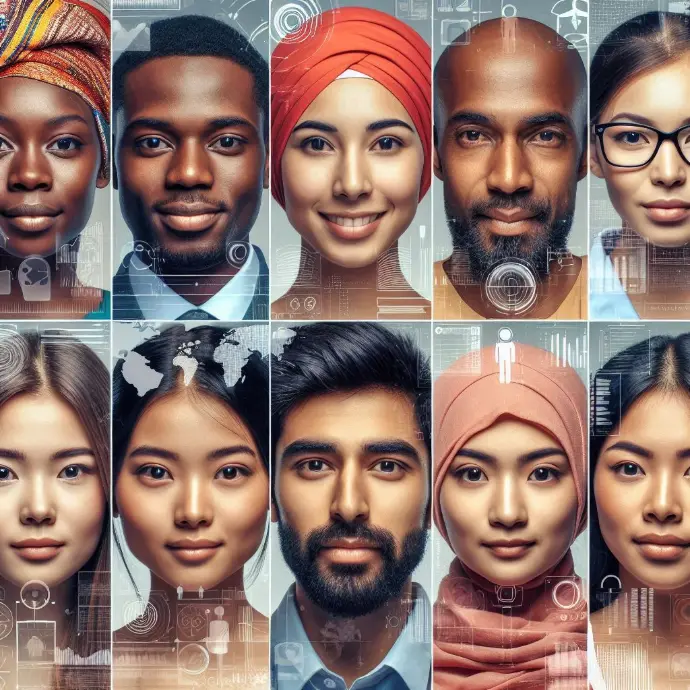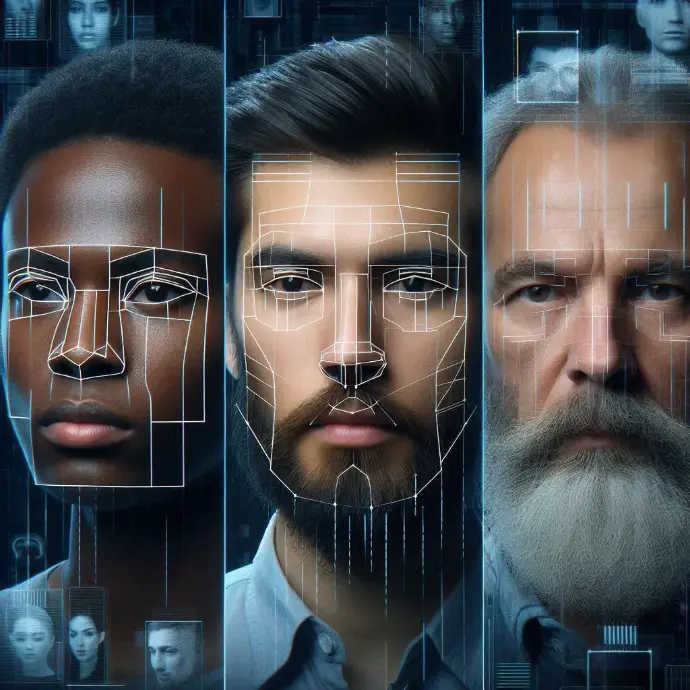
Biased Algorithms: How Does AI Perpetuate Racial and Gender Discrimination?
Back to page More information about DiscriminaciónHere you'll find a space dedicated to the careful exploration and in-depth analysis of human rights worldwide. In our feature article, "Biased Algorithms: How Does AI Perpetuate Racial and Gender Discrimination?", we address the shocking reality of discrimination in technology. Would you like to discover how artificial intelligence can perpetuate these prejudices? Go ahead, delve into a world of reflection and discovery!
Introduction
In the context of the increasing integration of artificial intelligence (AI) into various aspects of society, it is essential to analyze the impact of biased algorithms on human rights. Racial and gender discrimination, in particular, have received attention due to the influence of AI on decision-making in areas such as employment, justice, and financial services. The following will explore in detail how these algorithms can perpetuate discrimination and its consequences for human rights globally.
Biased algorithms, also known as discriminatory algorithms, refer to AI models that inadvertently or intentionally incorporate biases or prejudices based on characteristics such as race, gender, sexual orientation, or ethnic origin. These biases can manifest themselves in automated decisions that favor or disadvantage certain groups of people, perpetuating inequalities and violating fundamental human rights.
These algorithms can be the result of biased historical data sets, design decisions, or even a lack of diversity in development teams. As AI continues to play a crucial role in decision-making, identifying and mitigating biased algorithms becomes imperative to protect human rights.
Addressing these challenges requires a deep understanding of how algorithms are developed, deployed, and used in various contexts, as well as the application of ethical and legal standards to mitigate their negative impact on society.
The impact of biased algorithms on human rights is significant and encompasses crucial areas such as access to employment opportunities, equity in the judicial system, and the fair distribution of resources. The automation of decision-making processes through AI can exacerbate existing disparities and even generate new forms of discrimination, violating the principles of equality and non-discrimination enshrined in international human rights treaties.
The opacity in the operation of these algorithms also poses challenges for accountability and transparency, making it difficult to identify and correct potential biases. As a result, people affected by discriminatory algorithmic decisions may face significant obstacles in challenging such decisions and seeking redress for the harm they have suffered.
Given this scenario, it is crucial to establish effective monitoring and evaluation mechanisms for AI systems, as well as to promote the participation of human rights experts in the formulation and implementation of AI-related policies, in order to ensure that the fundamental rights of all people are respected and protected.
Racial and gender discrimination amplify the negative impacts of biased algorithms, as marginalized communities and women are often subject to systemic discrimination in numerous areas. Discriminatory algorithms not only reflect these inequalities but perpetuate them, which can translate into unequal access to employment, housing, credit, and other essential resources.
In the workplace, biased algorithms can influence hiring and promotion processes, reproducing patterns of discrimination based on race and gender. Likewise, in the judicial system, AI can contribute to biased decisions that disproportionately affect racialized communities and women, undermining their rights to a fair and impartial trial.
It is critical to address these issues by implementing gender and racial impact assessments in AI systems, as well as promoting diversity and inclusion in the tech industry to avoid reproducing bias in the development and implementation of algorithms.
Racial and Gender Discrimination in Algorithms
Racial and gender discrimination in algorithms refers to the presence of biases or prejudices based on race, ethnicity, or gender that affect the functioning and outcomes of artificial intelligence algorithms. These biases can influence automated decision-making, such as the selection of job candidates, loan approval, or court rulings.
Discrimination in algorithms can manifest itself in a variety of ways, from the unequal representation of different groups in datasets to the amplification of stereotypes and inequalities through process automation. Understanding and addressing these issues is critical to ensuring that algorithms do not perpetuate or amplify existing social injustices.
In the field of racial and gender discrimination in algorithms, numerous case studies have been documented that illustrate the negative impacts of algorithmic biases. For example, research has revealed that algorithms used in hiring processes can systematically discriminate against candidates of certain races or genders, even without the explicit intent to do so.
Furthermore, cases have been identified in which algorithms applied in the justice system have shown significant biases in sentencing, raising concerns about the fairness and impartiality of such automated processes.
These studies underscore the importance of thoroughly examining the implications of artificial intelligence in relation to racial and gender discrimination and implementing measures to mitigate these harmful effects.
Biases in algorithms can manifest themselves in multiple ways, from a lack of equitable representation in datasets to the generation of automated decisions that reflect and perpetuate stereotypes and inequalities. These biases can influence critical areas such as access to job opportunities, credit evaluation, healthcare, and the justice system, highlighting the urgency of addressing this problem.
Developing and implementing strategies to identify, mitigate, and prevent racial and gender discrimination in algorithms is crucial, requiring an interdisciplinary approach involving experts in ethics, human rights, artificial intelligence, and diversity. Only through a collaborative effort and a deep understanding of these challenges can we move toward a more equitable and responsible use of AI in society.
The impact of biased algorithms on society and human rights is significant and concerning. Racial and gender discrimination in algorithms not only affects the individuals directly involved but also has consequences at the societal and community level. The perpetuation of bias through artificial intelligence can exacerbate inequality, undermine trust in institutions, and undermine efforts to achieve equity and justice for all.
In the context of human rights, biased algorithms pose significant challenges in terms of discrimination and violations of fundamental rights. The use of AI in justice systems, procurement, healthcare, and other areas can lead to biased decisions that negatively impact marginalized, vulnerable, or historically discriminated groups. This not only contravenes the principles of equality and non-discrimination but can also perpetuate and amplify existing injustices in society.
It is crucial to address the impact of racial and gender discrimination in algorithms from a comprehensive human rights perspective, ensuring that the implementation of artificial intelligence respects the principles of universality, indivisibility, interdependence, and non-discrimination. This challenge requires a multidisciplinary approach involving experts in ethics, human rights, technology, and civil society representatives to develop robust regulatory frameworks and effective accountability mechanisms.
Analysis of the Impact of AI on Human Rights
Biased algorithms have a significant impact on equality and justice, perpetuating racial and gender discrimination in different aspects of everyday life. From job recruitment to lending, these algorithms can bias outcomes and contribute to inequality. For example, in recruitment, algorithms may rely on historical data that reflects existing biases rather than selecting the most qualified candidates, resulting in a less diverse and equitable workforce.
Furthermore, in the justice system, algorithms used to predict criminal recidivism often display racial biases, which can lead to harsher sentences for certain ethnic groups. This situation undermines justice and perpetuates discrimination, raising fundamental equity and human rights concerns.
It is critical to address these repercussions to ensure that AI does not contribute to the perpetuation of inequality and injustice, but rather becomes a tool to promote equality and equity in society.
Biased algorithms pose significant ethical and legal challenges, as they call into question the impartiality and fairness of automated decision-making. From an ethical perspective, the use of algorithms that perpetuate discrimination undermines the principles of justice and respect for human dignity. Furthermore, from a legal perspective, the existence of biased algorithms raises questions about the responsibility and accountability of the organizations that use them.
The lack of clear regulations surrounding the use of biased algorithms further complicates this situation, highlighting the urgent need for robust legal and ethical frameworks to guide the development and deployment of AI. These ethical and legal challenges must be addressed comprehensively to ensure that AI is used fairly and equitably, respecting human rights and promoting inclusion and diversity.
It is crucial to foster a global debate on these challenges to promote the development of policies and regulations that effectively address the ethical and legal issues related to AI and biased algorithms.
Given the problem of biased algorithms, it is essential to consider and develop possible solutions and corrective measures. One of the key strategies is the implementation of ethical and social impact assessments during algorithm development and implementation. These assessments allow for the identification and addressing of potential biases and discrimination before the algorithms are used in real-world settings.
Furthermore, promoting transparency and accountability in algorithm development is essential to mitigate the impact of discrimination. Publishing data and methodologies used in algorithm creation allows for greater independent oversight and evaluation, which contributes to the identification and correction of potential biases.
Likewise, diversifying algorithm development teams can help identify and mitigate bias by integrating diverse perspectives and experiences that enrich the process of creating impartial algorithms.
These corrective measures and potential solutions represent an important step toward mitigating the impact of biased algorithms on racial and gender discrimination, promoting the ethical and equitable use of AI for the benefit of human rights globally.
Conclusions
To mitigate discrimination in algorithms, it is essential to implement a series of actions that effectively address this challenge. First, it is crucial to conduct a thorough assessment of the datasets used to train algorithms to identify potential biases and prejudices. This assessment must include the equitable representation of diverse communities and demographic groups, thus ensuring the inclusion and representation of diversity in the data.
Furthermore, bias mitigation techniques, such as regularization, instance weighting, and synthetic data generation, must be developed and applied. These strategies are essential to counteracting the inherent biases in datasets and in the algorithms themselves, thus enabling fairer and more equitable decision-making.
Furthermore, it is essential to foster transparency in algorithmic processes, providing access to information about how decisions are made and what criteria are used. This transparency not only promotes accountability but also allows potential discrimination to be identified and addressed more effectively.
Awareness and regulation in the field of artificial intelligence (AI) play a crucial role in combating racial and gender discrimination in algorithms. It is essential that both AI developers and users are fully aware of the potential biases and prejudices that may be present in algorithmic systems.
Furthermore, the implementation of robust and ethical regulatory frameworks is essential to ensure that algorithms respect the principles of fairness and non-discrimination. These regulations should specifically address the detection and mitigation of bias, as well as establish oversight and accountability mechanisms to ensure that algorithms do not perpetuate racial and gender discrimination.
Ultimately, the combination of awareness, regulatory action, and collaboration among diverse actors—including developers, users, regulators, and human rights advocates—is essential to ensuring that AI is used ethically and equitably, thereby contributing to building a more inclusive and fair digital environment for all.



